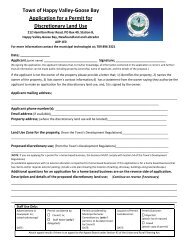Habitat Conservation Plan Habitat Conservation Plan for the Town ...
Habitat Conservation Plan Habitat Conservation Plan for the Town ...
Habitat Conservation Plan Habitat Conservation Plan for the Town ...
- No tags were found...
Create successful ePaper yourself
Turn your PDF publications into a flip-book with our unique Google optimized e-Paper software.
2 <strong>Habitat</strong> <strong>Conservation</strong> <strong>Plan</strong>Section 2: Wetland <strong>Conservation</strong> in Newfoundland andLabradorIntroductionHuman development has resulted in <strong>the</strong> destruction of many types of habitat all over <strong>the</strong>world. Wetlands are among <strong>the</strong> areas most critically affected by this development andare, in fact, one of <strong>the</strong> most sensitive ecosystems on <strong>the</strong> planet. Wetlands are uniqueecosystems that often occur at <strong>the</strong> edge of aquatic (water, fresh or salty) or terrestrial(upland) systems. They may be wet year-round, wet during certain seasons, or wetduring part of <strong>the</strong> day. In general, “wetland” refers to land that has <strong>the</strong> water table at,near, or above <strong>the</strong> land’s surface and refers to land which is saturated <strong>for</strong> a long enoughperiod to promote wetland processes. In addition to bogs and swamps, wetlands includetidal marshes, <strong>for</strong>ested wetlands, fens, estuaries and shallow open water (at a depth lessthan two meters). Healthy wetlands and associated uplands contain fresh, brackish or saltwater and are some of <strong>the</strong> most biologically diverse and productive ecosystems on earth.Wetlands play a major role in <strong>the</strong> status of continental ecosystem health, as well asregional and local ecosystem health. Wetlands serve as important buffers to flooding,function as enormous sinks <strong>for</strong> carbon and as natural reservoirs <strong>for</strong> <strong>the</strong> holding, purifyingand recharging of water resources. From an economic stance, wetlands are associatedwith a range of values from recreational and subsistence opportunities <strong>for</strong> hunting,fishing, trapping <strong>for</strong> food and fur, <strong>the</strong> ga<strong>the</strong>ring of fruit and berries and <strong>for</strong> non-extractiveactivities like wildlife viewing, ecotourism, paddling sports and hiking. Wetlands alsoprovide <strong>for</strong> <strong>the</strong> seasonal resource requirements of many waterfowl species and serve asimportant habitat <strong>for</strong> waterfowl throughout breeding, feeding, staging and over-wintering.All migratory waterfowl, many o<strong>the</strong>r migratory birds and half of all threatened andendangered species depend on wetlands and associated upland habitat <strong>for</strong> <strong>the</strong>ir existence.The number and diversity of North America’s wildlife species has been declining over<strong>the</strong> latter half of <strong>the</strong> twentieth century. At least a portion of this decline can be directlyattributed to <strong>the</strong> loss of natural habitats to urban, industrial and agricultural expansion.Wetlands have historically been among those areas most critically impacted by humandevelopment. Today, wetlands around <strong>the</strong> globe and within Newfoundland and Labradorare being looked at as viable options <strong>for</strong> development by a variety of industries andnatural resource based sectors, as technological advances make <strong>the</strong> alteration of wetlandsa reality. Canada, <strong>the</strong> United States and Mexico have signed <strong>the</strong> North AmericanWaterfowl Management <strong>Plan</strong> (NAWMP), <strong>the</strong>reby committing <strong>the</strong>mselves to a long-termprogram of partnership projects aimed at assuring <strong>the</strong> survival and increase of waterfowlpopulations and protecting <strong>the</strong> wetland habitat on which <strong>the</strong>ir survival depends. A totalof 21 joint ventures, ranging from species to regional-specificity, have been established toachieve and implement <strong>the</strong> objectives of <strong>the</strong> NAWMP. The province of Newfoundlandand Labrador, through <strong>the</strong> provincial Wildlife Division, became a partner of <strong>the</strong> Eastern<strong>Habitat</strong> Joint Venture (EHJV) in 1989.






